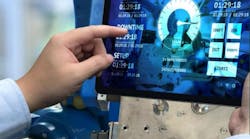We’ve already pointed out how the isolationist environment created by the COVID-19 quarantine gave new impetus to the already-underway migration towards collaborative software development solutions. There have been collaborative elements in legacy design software environments, but the forced separation of our current existence has forced the industry to move forward more aggressively to embrace the new work paradigm.
One of the more recent solutions presented to aid the design engineering team to achieve their goals, SystemLink from NI eliminates much of the effort in keeping test systems current and healthy, by automating processes. In addition to monitoring system health, SystemLink delivers key information to improve situational awareness and test readiness to help quality across the product lifecycle.
SystemLink ensures that software configurations are accurate, and test equipment complies with calibration and quality standards. Leveraging an automation and connectivity platform, SystemLink aggregates test and measurement data from all test systems into a centralized data repository, where users have access to asset utilization, calibration forecasts, and test result history, trends, and production metrics data. To get a better idea on how this solution addresses the needs of the engineering community, we talked to Penny Merian, NI’s chief product marketer of enterprise software.
EE: Okay. So now Penny, when we talk about enterprise software, that's a huge space. I mean, if you type enterprise software to Google, you'd be inundated. What makes SystemLink special, different? It's new? So what's new about it?
Penny Merian: You're right. Enterprise software is a big topic. I've worked in different variations of enterprise software most of my career, but what makes us unique are the problems we're solving. If you think of going from design to monitoring of a product, this allows you to use all the data to really inform the teams so that they can improve their designs.
I can deliver my products faster. I eliminate waste along the process, all the way to actually doing predictive analytics, to improve the overall efficiency of what I'm doing in manufacturing. So it's really about focusing on the continuum, from test operation to predictive analytics, as we look at the impact that test has within an organization, especially as we’re moving towards digital transformation initiatives, factory 4.0 or smart factories where there's a lot of focus on on the operational side, and there's a lot of focus on the design side, but that middle piece where there's a lot of inefficiency within the task, and the the usage of data, it addresses that.
Across the Lifecycle
Instead of doing that for one product or one group, what also makes it enterprise is looking across the development life cycle, from design and requirements all the way to monitoring in the field. So we’re looking across that life cycle, but we’re also doing that for distributed teams.
So if I'm in a manufacturing organization, I'll just take NI as an example, and I have locations in multiple countries, I can be looking in monitoring my systems, and looking for and proactively identifying any drift issues, or those kinds of things back in Austin from a central location. So it's that distributed view and the ability to standardize that makes it that class of enterprise software for the test operations and process analytics.
EE: Well, what immediately jumps to mind, and this is a topic that keeps coming back, is how COVID-19 is changing how we work. One of the things that we’ve pointed out is this is literally the kind of a perfect storm that will... Because people have been talking about collaborative software, collaborative design software, aggregated software, whatever label you'd like to put on it. This has been something that the industry has been trying to push forth in one flavor or another over the past decade; but it seems now with COVID-19 companies are being literally confronted with "it's time to railroad mentality". We've got to literally get off the pot, as it were.
Penny Merian: Yeah, and it becomes even more critical as you look at some of the inefficiencies. If I just look at system readiness, you now need to test the product, whether it's validation, or production, or it's out in the field. What if I can't get there and manually walk around, how do I know my configurations are good? A lot of our customers, where we've seen significant ROI impact, are just eliminating that walking-around using USB sticks to update software, or waiting for memory leaks to happen before they realize there's a problem with the data, right?
Being able to remotely manage and remotely configure, even that simple step to ensure your systems are healthy, or to be able to centrally manage the data, so no matter where I am, I can look to see am I having a first-pass yield problem and be able to root-cause it without actually having to be on the floor.
Remote access is quite honestly a safety issue. I don't have to go into these environments, and that becomes more and more important. What we're also seeing is COVID-19 has introduced that speed to manufacturing and bringing products to market, that's accelerated a lot of the digital transformation initiatives. It's not good enough to say, "Hey, I know it's going to be important, but I don't have time to do it", now you can't afford not to.
So the use of data readiness to be able to have real-time information, that's been normalized and aggregated across multiple stations, can actually determine things before they come. It has been a necessity, and COVID-19 has helped accelerate that, and hence good timing for SystemLink.
Peripheral benefits
EE: Got it. Now, any good solution solves multiple problems, so what are some of the other things that SystemLink can indirectly benefit that wasn't necessarily in its primary job description?
Penny Merian: Some of the benefits that our customers have seen? We knew that there would be time savings, that's one of the cores in the systems management piece, that's all about removing those inefficiencies. So building test stations quickly, making sure they're meeting, they're in calibration, they have all the right software. So we knew that was going to be a big deal.
So people like Cree Lighting who took several hours to set up a machine to less than 10 minutes to set up a production floor. That was what we expected, but some of the things we didn't expect, like the Toyota example where they not only increased the man hours to do analysis in one department by over 50%, but Jaguar, Land Rover had the same result, where before they were analyzing a small portion of their data. In Jaguar's case, it was less than 10% to now being able to use that asset for 95% of their data.
That has resulted in a reduction of the cost of test. So when you think about the business impact of that, if I've got cost pressures on my product, and I've got inventory, or I should say I've got pressures and time to market, if I'm able to reduce the cost of test, and improve coverage so I don't have to do reruns, and I don't have to do recalls, I can be confident that the product in the field is what I want it to be. That's huge.
Those are some of the side benefits that make sense once you hear customers achieve it. We also have a customer or large software manufacturer who took the commissioning of a data center from 18 months to nine months. So it's this magnitude of efficiency gains that people are getting from SystemLink that is surprising us. There's also cost avoidance. One of our customers achieved a 10X faster post-processing of a million datasets, and that saved them 50K per test by simply avoiding the cost of rerunning a test.
When you think about hidden costs of test reruns because I either can't find the data or it's not normalized, I've taken temperatures in Fahrenheit, one in Celsius, and it's not normalized or it's old, I work in spreadsheets, I put it in PowerPoint. By the time I look at it, it's already old. So those kinds of hidden costs create huge savings. That was a really, really pleasant surprise of the outcome of the software.
EE: Is there anything else you wanted to leave us for the audience about SystemLink?
Penny Merian: Yeah. I think when you think about optimizing what you're doing, and trying to deliver things faster with the highest quality, one of the ways to do that is to improve or eliminate inefficiencies and automate the manual tasks. So you're now up-leveling your engineers to be able to quickly analyze those reports, actually make changes, and be able to impact either the tests that are running and validation, and provide better recommendations back to development.


